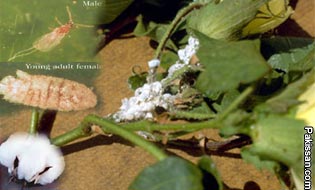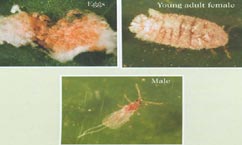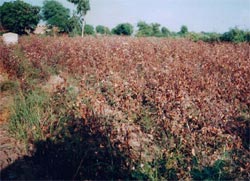Mealy bug: An emerging threat to cotton crop
By Mohammad Ali Khaskheli
Cotton is the most
important fiber crop of Pakistan. It plays pivotal role
by providing fiber, food and fuel and earns foreign
exchange. The cotton provides raw material to all
textile mills, ginning factories and oil mills. It is
also used for edible oil, which makes about 80% of
national oil production. Cotton has much more important
utilization in our economy as well as in our culture
therefore; it is regarded as the mother of civilization.
 The
growers of Pakistan are suffering huge losses in yield
and quality of cotton crop due to attack of various
insect pests and diseases every year. In Pakistan,
cotton crop is attacked by about 150 types of insect
pests; which act as significant limiting factor in
increasing its production. Because of their improper or
un-integrated management, our cotton production is very
low as compared to many other cotton producing countries
of the world. The
growers of Pakistan are suffering huge losses in yield
and quality of cotton crop due to attack of various
insect pests and diseases every year. In Pakistan,
cotton crop is attacked by about 150 types of insect
pests; which act as significant limiting factor in
increasing its production. Because of their improper or
un-integrated management, our cotton production is very
low as compared to many other cotton producing countries
of the world.
Cotton crop is easily damaged by pests, so cotton
growers are always looking for ways to protect their
crops. The present situation of cotton field, with
special reference to Sindh province, needs special
attention, where about the crop is suffering from an
emerging problem of mealy bug pest (fig.1).
 Fig.1- Hibiscus Mealy bug Fig.1- Hibiscus Mealy bug
This pest occurs in most tropical areas of the world,
including Asia, the Middle East, Africa, Australia, and
Oceania. The mealy bug arrived in Egypt from India in
1912 and in Hawaii in 1984. It appeared in Grenada,
Trinidad, and St. Kitts in the1990’s and has spread to
other islands in the Caribbean, where it attacks many
hosts of economic importance.
Mealy bug Maconellicoccus hirsutus is a small, scaled
insect 1/5th of an inch long (about the size of a small
red ant) that gets its name from its appearance, which
looks as if it has been rolled in coarse flour. Female
adult is approximately 3 mm in length (1/10 inches),
wingless, and have piercing–sucking mouthparts. A white
cotton-like wax covers the female’s reddish body. When
punctured, the female’s body fluids are also reddish,
but it is important to note that some other mealy bug
species may have a similar coloration.
Mealy bug belongs to order Hemiptera, sub-order
Homoptera, family Coccidae, sub-family Pseudoccidae. The
super family Coccoidea includes mealy bugs and scale
insects. Mealy bugs overwinter as eggs on stems, in
soil, in cracks and crevices in the stem, and inside
crumpled leaves. Freshly laid eggs are orange but turn
pink just prior to hatch. The crawlers disperse from the
ovisac by way of walking, wind, or ants. The nymphs feed
and develop into adults in approximately 30 days. The
insect has a life cycle of 24 to 30 days. The female
mealy bug produces 10-15 generations per year in
colonies of 500-600 eggs.
Mealy bug is a serious pest in many parts of the world
where it causes serious damage to a variety of crops.
This mealy bug attacks more than 300 plant species
including rice, sugarcane, cotton, fruits; papaya,
carambola, avocado, citrus, sugar-apple, sour sop, mango
breadfruit, golden apple, cherry, plum, guava, pigeon
pea, passion fruit ,grape, banana; vegetables, tomato,
cucumber, pumpkin, peppers, okra, dasheen, lettuce
cabbage, beans, squash; ornamentals hibiscus,
bougainvillea, croton, oleander, allamanda, ixora,
anthurium, ginger lily, heliconia, schefflera, lantana,
ficus, seagrape, and numerous weeds etc.
It feeds on the sap of the plant and releases toxic
substances causing injury, curling and drying of leaves
which, damages fruiting and drastically decrease the
yield. Mealy bug also attacks the roots just below the
level of the soil, especially where the root and the
stem meet. Root mealy bug lays their eggs in sacs of
interwoven filaments that resemble cotton wool. Mealy
bug also excretes large quantities of honeydew onto the
plant that in turn attracts ants and sooty mould. Keep
ants under control as they may distribute the pests to
other plants. It is also spread by wind, or it can be
stuck on clothing or on the hair of animals. Mealy bug
can spread rapidly once introduced in an area
In Sindh the minor infestation of mealy bug had been
reported on cotton crop since last so many years, but
during September 2005, a severe damage of mealy bug was
recorded first time on an area of about 3000 acres in
Kot Ghulam Mohammad, Tandoallahyar, Mirpurkahs and
Sanghar district (fig.2). The problem was appeared late
when cotton crop was mature. But this year the attack of
mealy bug has been observed in early stage of cotton
crop in district Sanghar and spreading very fast (The
daily Dawn June 2, 2006).
 Fig.2- Cotton crop severely affected by mealy bug at Kot
Ghulam Mohammad Fig.2- Cotton crop severely affected by mealy bug at Kot
Ghulam Mohammad
Cotton plant with mealy bug damage
Though the infestation still has not reached at alarming
situation but if the pest is not controlled it would
cause severe damage to the crop. Furthermore it must be
remembered that once mealy bug pests become established,
it is extremely difficult to achieve acceptable control.
Signs of Mealy bug Infestation
One or more of the following symptoms may be observed:
• Crinkled or twisted leaves and shoots
• Bunched and unopened leaves
• Distorted or bushy shoots
• White fluffy mass on buds, stems, fruit, and roots
• Presence of honeydew, black sooty mold, and ants
• Unopened flowers which often shrivel and die
• Small deformed fruits.
Management Options
In recent days our experience in the district Sanghar
has shown that only the chemical control has become very
difficult. The mealy bugs produce large amounts of
honeydew (similar to that of produced by whiteflies and
aphids), which can coat plants and surrounding surface
with a sticky or waxy layer of honeydew (fig-3).
Pesticides cannot easily penetrate the heavy wax layers.
Therefore, applying pesticides only is an ineffective
control technique against this mealy bug pest. Thus
mealy bugs cost growers and retailers million of dollars
per year in control costs and crop damage throughout the
world. However the managements should include following
integrated control options.
• Weeds serve as host plant therefore they should be
eradicated regularly.
• The severely infested plants must be cut and burnt
immediately and field should be ploughed to kill
immature stages available in the soil.
• Spray as strong a stream of soapy water solution as
the plant can tolerate; this should dislodge most of the
bugs. This is the easiest way to control mealy bugs.
Repeat if you see new egg sacs.
• Spray with a soap/oil (Mix 1 tsp. detergent surf +100
ml neem oil, and 16 liter water in a spray tank) mixture
may also give better results.
• The less affected crop at early growth stage should be
sprayed with Imidacloprid (120 gram/acre) or
Thiamethoxam and may be repeated after 5-7 days followed
by water spray. The spray should be done at the crawler
stage of mealy bugs, because it is the most fragile
stage and the most susceptible to chemical control.
• The foliar spray of Chlorpyrifos, Triazophos,
Profenofos, and Bifenthrin may be applied at later stage
of crop. (i.e. after 100 days of sowing).
• Prior to the spray of Imidacloprid, Chlorpyrifos @ 2
Liter per acre should also be applied through irrigation
as to control the root infestation and suppress the pest
population in the soil.
• Biological control offers the safest, most economical
and long term solution to this problem. This strategy
relies on producing sufficient numbers of tiny wasps
(parasitoids) that attack and kill the mealy bug. A
number of natural enemies are known, including the
coccinellid predator Cryptolaemus montrouzieri and the
parasites Anagyrus kamali and Gyranusoidea indica which
suppress the mealy bug population. In Egypt and India,
biological controls have been quite successful in
suppressing the mealy bug. Other coccinellid predators
have also been reported in India. At present, 21
parasites and 41 predators are known to attack this pest
worldwide.
In last it must be remembered that once mealy bug pests
become established, it is extremely difficult to achieve
complete control.
Courtesy: The writer is parmanent contributer of the
Pakissan.com |
|
Pakissan.com;
|